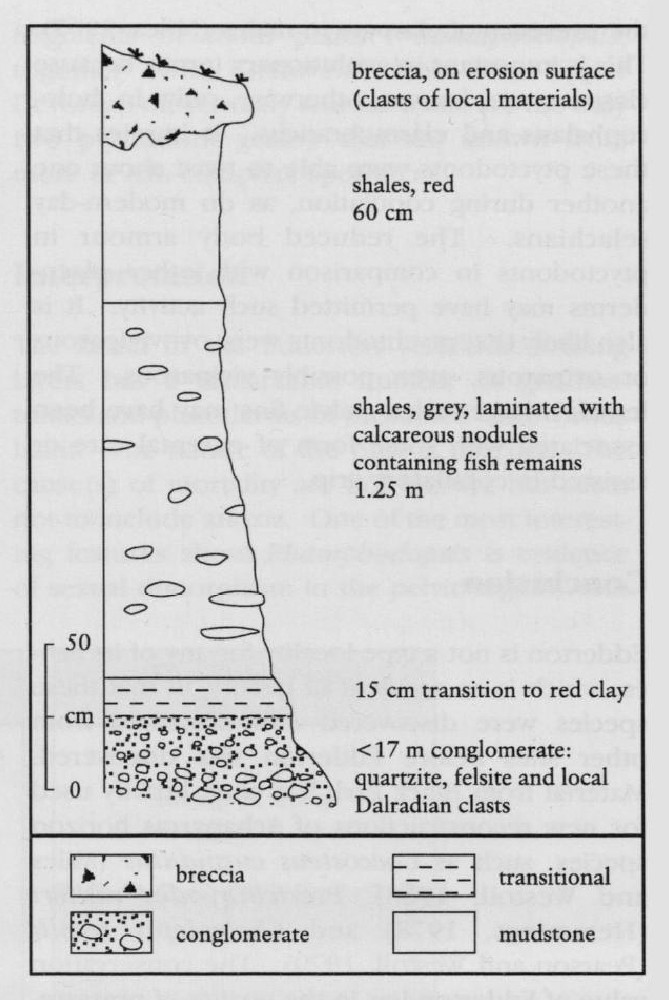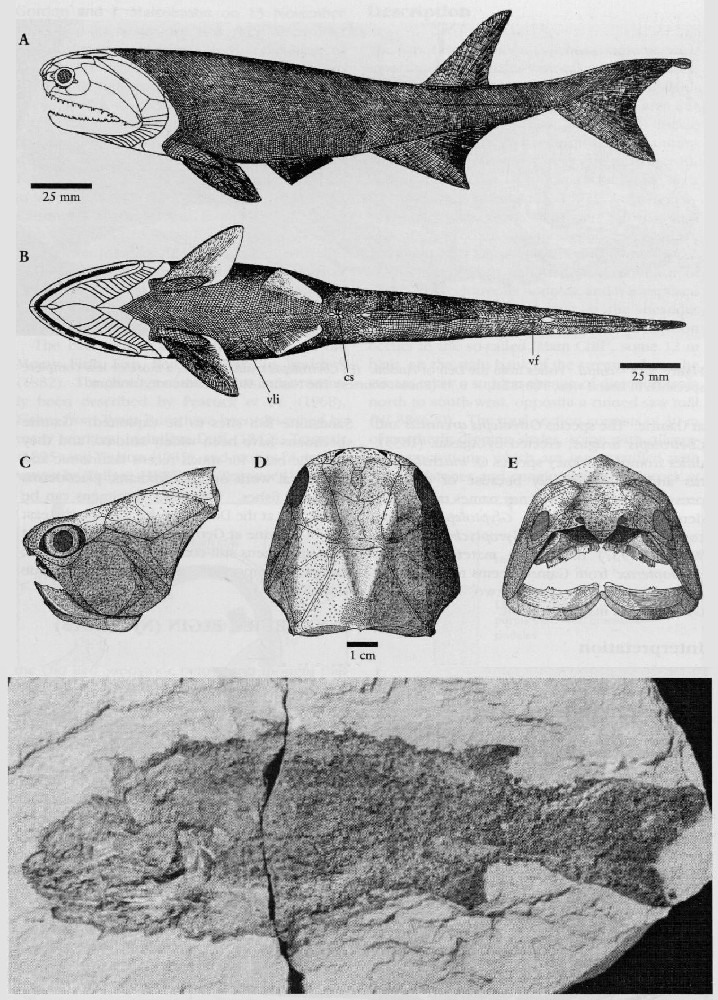Den of Findon, Gamrie
Highlights
The Den of Findon, near Gamrie, Grampian, has produced a fauna of 12 species of fossil fishes from nodules. The site is the easternmost at which fishes of the Achanarras horizon can be found, and it shows an example of fish life on the south-eastern margin of the great Orcadian Lake.
Introduction
The Gamrie Fish Bed is the most easterly outcrop of the Achanarras horizon and it yields 12 species of Middle Devonian fishes (see Hamilton and Trewin, 1988, p.590). Specimens from the fish bed were described early in the 19th century, and a great deal of material is now in museums around the world. Murchison came to the site in 1826, during his visit to Scotland, when he first saw Old Red Sandstone fishes in Caithness, but he failed to observe this fish bed. It was discovered during the following winter, when an overflowing mill stream caused a landslip in the blue clays containing the nodules (Murchison, 1828). Impressed by the thick rhomboidal scales and heterocercal tails of one of the Gamrie species (Osteolepis), Murchison compared them with the Permian palaeoniscids of Germany (Andrews, 1982), but did not recognize the resemblance between these fossils and those from Caithness, because of differences in style of preservation. The nodules were noticed by a Mr Docker of Findon Farm and James Christie, a solicitor from Banff (Prestwich, 1837), and collections were dispatched to the Geological Society in London. Murchison sent fish specimens to Joseph Pentland, in Paris, and published his descriptions of two, possibly three, new species of fishes, the so-called 'Gamrie ichthyolites', in 1828.
Gamrie then became an important collecting site. Dr Knight of Aberdeen was responsible for a large collection of Gamrie ichthyolites, which provided the materials for early descriptions of Middle Devonian fishes. Agassiz (1835) described specimens from Gamrie sent to him by Murchison, Knight and J. Torrie. From this material, he erected three new species, two of which represented new genera. Gamrie was the type locality for Osteolepis arenatus, Cheirolepis uragus, and Cheiracanthus murchisoni, which are now no longer valid species, the last of which, however, is common at Gamrie. Agassiz (1835) argued that the Gamrie deposits were younger than those of Orkney, and that they belonged to the Coal Formation because 'they seem to be so nearly related to that deposit that he (could not) regard them as of much more recent origin' (Agassiz, 1835, quoted in Andrews, 1982).
Prestwich (1838, 1840) supported the conclusions of Agassiz. He regarded the fish bed and conglomerate as resting unconformably upon the Old Red Sandstone below, and thought that they were probably representatives of the Carboniferous Millstone Grit or Mountain Limestone. This was challenged by Malcolmson (1842) who showed that there was no unconfor-mity. Geikie (1878) described the geology of Gamrie, as did Read (1923). Read also gave a list of species from the fish bed compiled by Traquair (Read, 1923, p. 172). The Gamrie fauna was discussed by Hay-Cunningham (1843), Agassiz (1833–1845), Smith (1851), Gregory (1860), Traquair (1880, 1895), Edward (1889) and Woodward (1891a). Gamrie fishes have also been described repeatedly in the 20th century (Heintz, 1938; jarvik, 1948a; Miles and Westoll, 1968; Hemmings, 1978; Pearson and Westoll, 1979).
Description
The Middle Devonian
The Gamrie fish bed is now rather inaccessible because of the crumbly vertical faces of conglomerate in the ravine, and collections have always been made from the loose nodules which accumulate in the stream bed below the exposure. The section given by Read (1923, p. 171) from the Den of Findon
| Thickness | |
| 'Bed 7, Breccia | 2–15 ft [0.6–4.6 m] |
| Red clay and shales | 2 ft [0.6 m] |
| Bed 6, Grey clay with ichthyolites | 4 ft [1.2 m] |
| The limestone nodules are restricted to the lower portion of the grey clay. Grey shales with plant remains occur locally above the underlying conglomerates | |
| Bed 5, Conglomerates with intercalations of sandstone | 50 ft [15.2 m]' |
The dip is 8° ENE, and the fish bed only crops out near the top on the east side of the ravine, where it can be traced along most of the length of the ravine. Trewin and Kneller (1987) described the section and the preservation of the fishes. Fishes are found in calcareous nodules, which also preserve the fine parallel laminations of the original mud. They are preserved complete, or with only slight disturbance of the carcass, but only the parts that occur within the nodules are fossilized.
Fauna
Acanthodii: Climatiformes: Diplacanthidae
Diplacanthus striatus Agassiz, 1835
D. tenuistriatus Traquair, 1894.
D. (Rhadinacanthus)longispinus (Agassiz, 1844–1845)
Acanthodii: Acanthodiformes: Acanthodidae
Cheiracanthus murchisoni Agassiz, 1835
C. latus Egerton, 1861
Placodermi: Antiarchi: Pterichthyodidae
Pterichthyodes milleri Miller, 1841
Placodermi: Arthrodira: Coccosteidae
Coccosteus cuspidatus Miller, 1841
Osteichthyes: Actinopterygii: Cheirolepidae
Cheirolepis trailli Agassiz, 1835
Osteichthyes: Sarcopterygii:
Osteolepidiformes: Osteolepididae
Glyptolepis leptopterus Agassiz, 1844
Osteolepis macrolepidotus Agassiz, 1835
Gyroptychius 2 n. sp.
Acanthodians are common at Gamrie, which is the type locality for Cheiracanthus murchisoni, and the source of two of the three syntypes of Diplacanthus tenuistriatus (the other is from Orkney). The placoderms Pterichthyodes milleri and Coccosteus cuspidatus are also common at Gamrie
Osteolepis and Cheirolepis are relatively rare at Gamrie. The species Osteolepis arenatus and Cheirolepis uragus, erected by Agassiz (1835), differ from the Orkney species O. macrolepidotus and C. trailli only because of differing preservation, and the Orkney names take precedence (Traquair, 1888b). Glyptolepis is fairly common at Gamrie, but Gyroptychius is rare. Westoll (1937) noted that material labelled Diplopterax)from Gamrie seems to be distinct from Gyroptychius, so two species of Gyroptychius may be present.
Interpretation
The evidence at Gamrie (Trewin and Kneller, 1987) indicates that the deposition of the fish bed, over a period of about 4000 years, was followed by uplift and an influx of locally derived breccias. Probably the fish bed was eroded away in many places, leaving the breccia lying directly above the conglomerates, as for example, near The Snook and at Pennan.
There are differences in faunal assemblage between Gamrie and other sites; for example Dipterus, which is common elsewhere, is entirely absent from the extensive collections from Gamrie.
Conclusion
The Gamrie fish bed is historically important as one of the first prolific Scottish Old Red Sandstone fish sites to be exploited. Gamrie specimens have been widely studied, and they form the basis for much recent taxonomic and anatomical work on acanthodians, placoderms and bony fishes. Today fish specimens can be found only at the Den of Findon site, on the east side of a ravine at Geordie Craigs, but sufficient good specimens still come to light to justify the continuing importance and conservation value of the site.


